Every film starts with a story and that includes CHRISTOPHER ROBIN whose story picks up after the final A.A. Milne book, “The House At Pooh Corner” in which Christopher Robin heads off to boarding school. Fast forward and we are reintroduced to the gang of Pooh, Tigger, Eeyore, Piglet, Kanga, Roo, Rabbit and Owl, and the special bond between a boy and his bear, complete with the unforgettable “Pooh Sticks” game. With a sweet montage that looks at Christopher Robin’s years since leaving Pooh and pals, we finally catch up with him in London at his wits end with a dead end job at Winslow’s luggage, always working, looking to saving for the future and not living in the present, and forgetting the things that he once held dear – family and friends. We also catch up with Pooh who has lost his friends and can’t find them in the fog within The Hundred Acre Wood. Oh, what to do, what to do! “What to do” is right as with Pooh, Tigger, Eeyore and Piglet around, there’s bound to be plenty going on with our silly old bear in the thick of it.
With the release of CHRISTOPHER ROBIN on Digital/Blu-ray/DVD (complete with bonus features), I had a chance to speak with screenwriter ALLISON SCHROEDER, costume designer JENNY BEAVAN, and once again with voice actor JIM CUMMINGS in some exclusive interviews and talk about all things Pooh.

Describing herself as “the last writer standing”, screenwriter ALLISON SCHROEDER came on board CHRISTOPHER ROBIN after scribes Tom McCarthy and Alex Ross Perry. “Alex started the project a few years before I came on board and then I think Tom did a draft and then I sort of came on board and worked on it all through pre-production and production and post-production. Alex and I actually got to work together a little bit in post-production which rarely happens for two feature writers which was just a lot of fun for us.”
Of course, with all the stories about Winnie the Pooh and Christopher Robin that could be told, for Schroeder the obvious place to start was after the final chapter of Milne’s book. “This idea had been in development, the idea of a grown-up Christopher Robin, for decades at this point, and I think a lot of people along the way were just really taken with that final chapter and where could it lead the story. And Alex was the one that decided to sort of set it post World War II, and the idea of the soldiers were returning home and the drudgery of life and later what it was like back then and through the pressures of work. I just came on board and kept working with that idea, trying to figure out how to create stakes and conflicts in the world of Pooh which is actually a very simple sweet world, and what could their journey be together.”

But with the changing time and place, also comes the task of a changing POV. All prior incarnations and iterations of Pooh and company have been told through the eyes of a young boy (Christopher Robin) or through the fluff and stuff of our favorite silly old bear. With CHRISTOPHER ROBIN comes the challenge of not only incorporating that changing POV but also retaining the essence and simplicity that makes Winnie the Pooh so beloved. Calling this “one of the most difficult scripts” she’s written “because [of] keeping the tone of Pooh and sort of the simplicity of it but also making a feature film that would resonate with adults as well”, one of the first focuses was on adult Christopher Robin. “[W]e realized that he shouldn’t be the boss bossman at work. . .He was sort of a manager but he was a cog in the wheel himself and he used to be a hero, and he didn’t know how to be a hero anymore. One day I realized that each of his co-workers should mirror a Hundred Acre Wood character and he can’t figure out how to save them. When he gets to the Hundred Acre Wood, he doesn’t know how to be the hero there. So once we hit on that it was sort of a no-brainer. But we went through so many versions of the Hundred Acre Wood until we landed where we did, to sort of find his journey.”
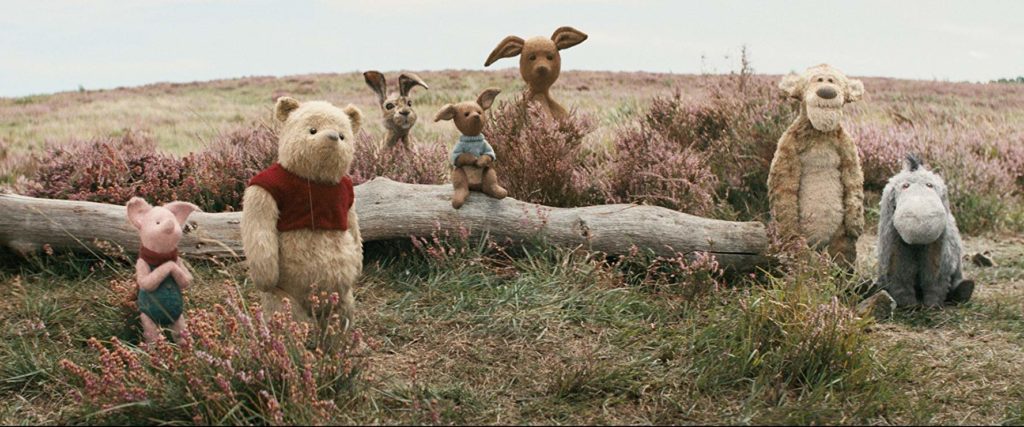
Notable is that CHRISTOPHER ROBIN is very balanced in terms of screen time amongst the characters and their interaction with Christopher Robin who, of course, maintains the greatest relationship and most screen time with Pooh. But again, not an easy task for Schroeder. It was just a few weeks into her work on the script when she “realized that when they get to the Hundred Acre Woods he needs to lose Pooh again. . . that Christopher Robin has to start to wonder, maybe there is something dangerous here. If you could separate him from Pooh, by doing that we could then have time to really meet each of the characters. We knew immediately the next character was Eeyore. I mean, I adore writing Eeyore! I adore him so we knew we had to do Eeyore and then we knew Piglet, and then he’d all find them in a mess. We realized that that was sort of a little Wizard of Oz-y, you know, The Hundred Acre Woods, and he gets to re-meet each of the characters and so do we. . . I think we just wanted to keep the story so simple and so relatable and so true to the kid in all of us, and the adult that’s trying to recapture that kid.”
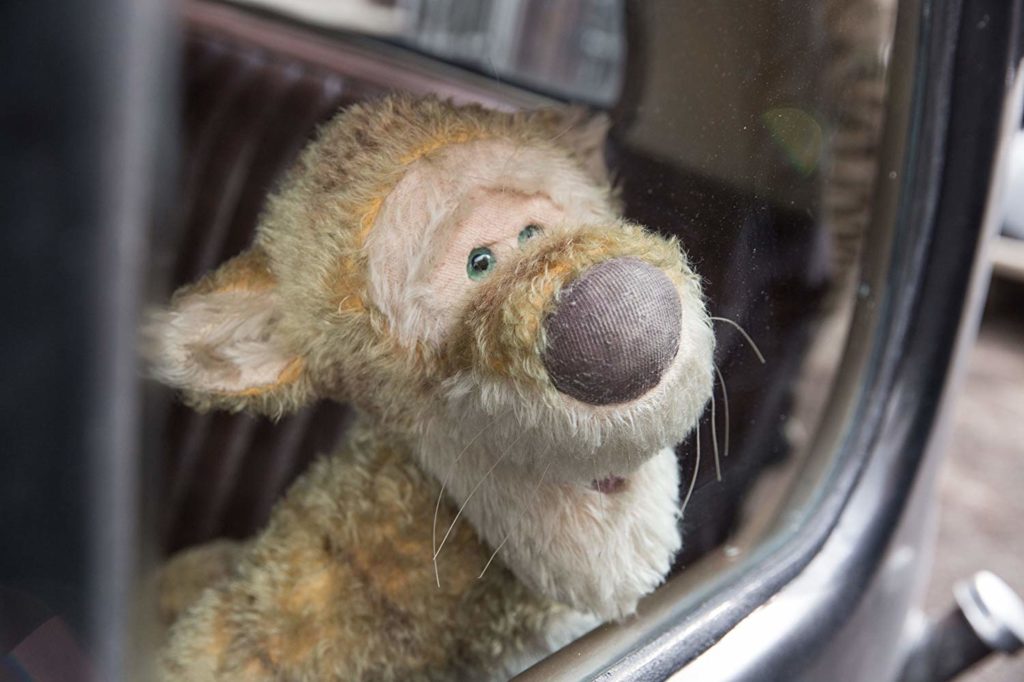
Many writers are influenced by various factors when writing a script, like a specific actor’s voice, for instance. With CHRISTOPHER ROBIN, each of the voices of the characters from The Hundred Acre Wood is immediately identifiable thanks to the early voices of Sterling Holloway as Pooh and Paul Winchell as Tigger. Thankfully, we have had the mastery of JIM CUMMINGS for the past 30 plus years picking up the mantle for both characters and as he has jokingly said in the past, “I’m really Jim Cummings doing Sterling Holloway doing Pooh.” But does Schroeder hear those voices in her head when she writes, as the cadence, the rhythm, the tonal inflections, all of that is going to come into play with the actual words being spoken? “Absolutely. There was definitely a learning curve on this and then that moment when I could start to really write each of the characters and each of the voices. . . And then we had the table read with Brad Garrett (Eeyore) and Jim Cummings (Pooh and Tigger) and the moment they started speaking, my pen came out on the script and I started scribbling notes and adjustments here and there to really make it their voice and their cadence, and even the way they do words and the wordplay. That was a lot … I mean the dialogue in this film was incredibly carefully crafted.”
Interesting is that despite his years of voicing Tigger, JIM CUMMINGS was not originally cast to voice him this go round. “I wasn’t asked as Tigger in this movie originally which knocked me for a loop, I didn’t know what to do with myself. But you know, you just soldier on and I guess after they started showing [the film] people just went ‘Oh. Wait. This isn’t Tigger.’ I think it was just too late in the game to completely reinvent one of the major characters. He had already recorded and to a certain extent, they had already choreographed it so to speak. That in itself was a challenge because the rhythms were very different than my own would of been, but we made it work.”
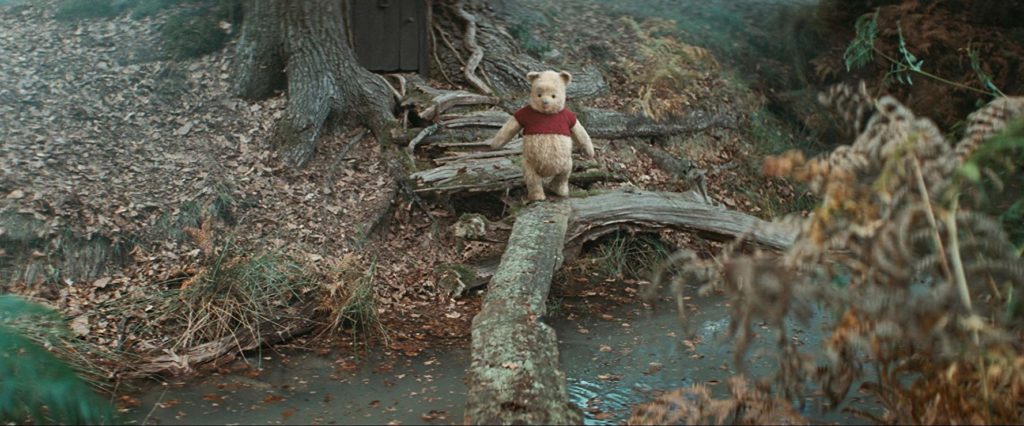
A dialogue-heavy film but filled with plenty of action, Schroeder “like[s] to be involved with all the little choices and all the little details because the best storytelling is often the ones without dialogue. I think that there are so many moments that I love actually in some things that if you write it on the page and then you see it and you go, you don’t need those four lines, those two characters can do it with a look. And that’s the beauty of film, right? That’s why I’m writing screenplays and not novels. But a lot of my humor comes in the action, so I love to try that all out and come up with fun beats like the gramophone on the head, and the cupboard and the ladder joke, all that stuff. I think that’s all some of the best part of writing.”
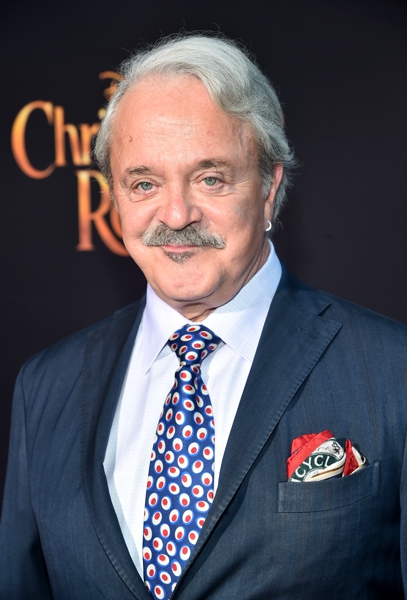
For Cummings, having voiced Pooh for so many decades now, and Tigger too, what sets these portrayals, these iterations of the characters apart from the Pooh stories of the past is that “it’s a more understated situation. There’s a quiet elegance to it. This movie was a period piece really, from the 20s to the 40s. I’ve said before, there was no runaway trains in here. He was on a train but it wasn’t very dangerous. There’re no waterfalls spilling over or hot air balloons that they have to safely land from. So, therefore, it’s less boisterous overall. . . [S]ince it was a story about Christopher Robin, it was about Pooh kind of guiding Christopher back to his childhood and to that which is important, and what used to be important to him. It’s like he said, will you ever forget about me, not if I live to be a hundred. And he kinda did. And he lost his way a bit. Pooh came back into his life and then reconnected him with his life and there’s a certain sweetness to that, that speaks to everyone. It was very different in that sense because usually, it was Christopher saving the Hundred Acre Wood gang. This time it was reversed and it came out so beautifully.”
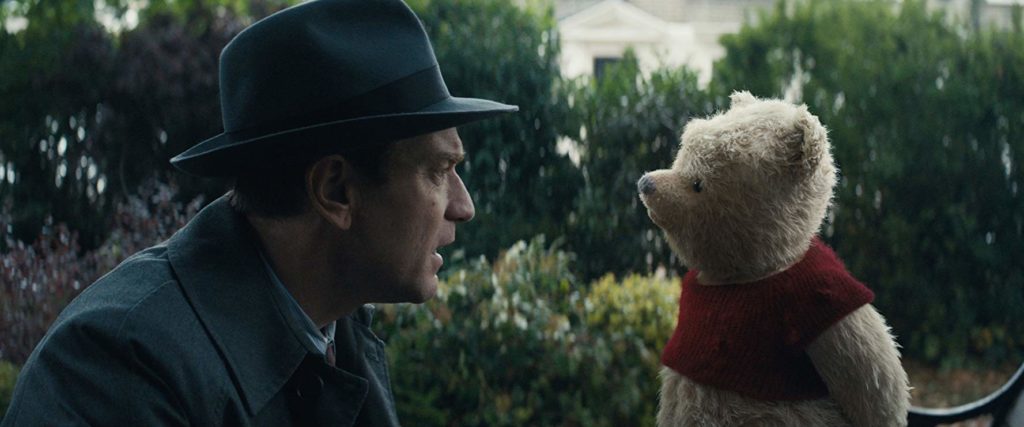
With this quiet elegance crafted in Schroeder’s script, it opened the door for Cummings to inject more subtlety into the vocal storytelling versus some of his other Pooh experiences. With that built-in subtlety, comes the responsibility to serve the story. “Marc Forster’s vision was just so elegant, beautiful and charming and I think everybody reconnected to their childhood through it.” Of course, the real challenge comes with Tigger and bringing subtlety to his bouncy, trouncy, flouncy pouncy exuberance. “He’s still gonna be Tigger!”
But once you have the words on the page and the characters fleshed out, a film needs visual presentation and a very large part of that comes with costume design. Thanks to JENNY BEAVAN, not only do we have a period perfect look, but the perfect matching signature red sweaters for Pooh and Christopher Robin and in that unmistakable shade of red. “We certainly did the red of the sweater and knitted the sweater, [although] I did not personally. My trainee, who’s a fabulous knitter, actually knitted the sweater and, we certainly helped with Piglet’s sweater and Roo’s scarf, and were just generally involved. Giving credit where credit is due, Beavan is quick to note that all of the fluffies – Pooh, Tigger, Eeyore, Piglet, Kanga, Roo, Rabbitt and Owl – were all courtesy of “Animated Extras. . . an incredibly clever animated prop company at Shepperton’s Studios.”
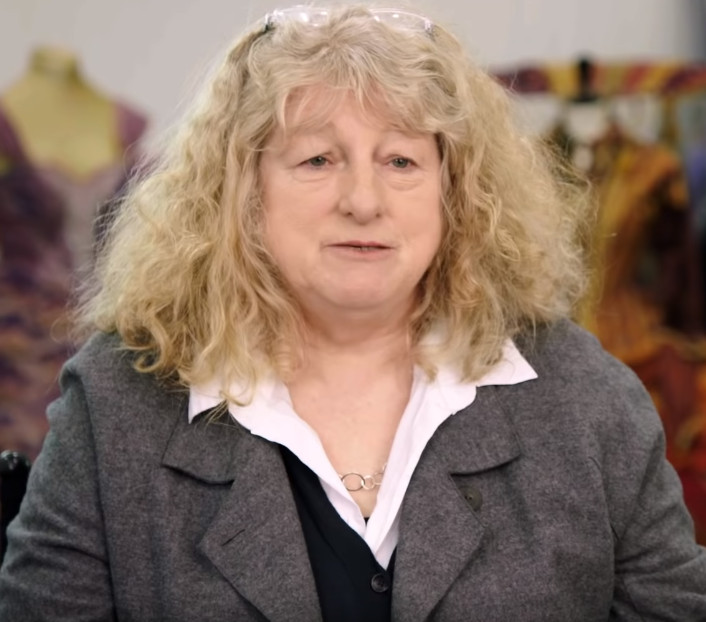
After reading the script and conferring with director Marc Forster it was clear to Beavan that “Marc Forster wanted this very monochromatic post-war Britain look [which] was incredibly helpful because then the animals could pop out against our very neutral [clothing palette], what people wore in those days. And I hate to tell you but I remember it, well, I remember some of it, because I grew up in the 50s and, I remember the end of rationing, and I remember how very few clothes people had too. My father had, because he was a musician, he had his tailcoat and his dinner jacket for concerts. He had a dark suit for recitals, and then he sort of had a couple of sports coats and flannels and that was it. And we only had a couple of pairs of shoes. Your indoor shoes and your outdoor shoes. It was a very different time, so I could tune into that. But that sobriety of color and, obviously it was all pretty natural fabrics then, I think really helped tell the story because of Christopher Robin being in a bad head-space, but also to show how the animals and the joy of them could actually be really shown off well against the simple grays.”
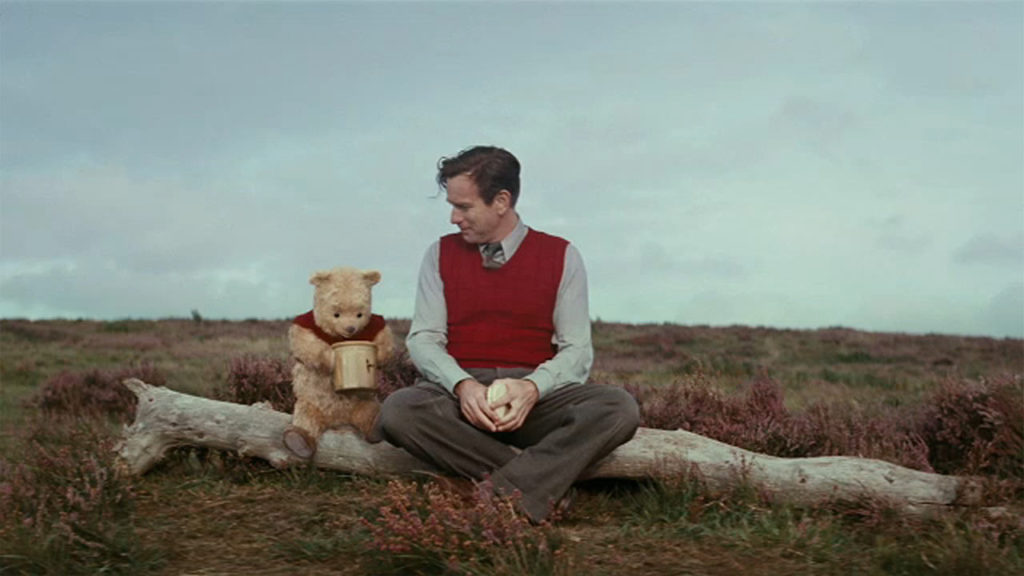
A period piece such as CHRISTOPHER ROBIN is often a blessing for a costume designer as many of the costumes necessary can be found in costume shops. For Jenny Beavan, that meant working with one of her favorites Cosprop. “I normally work out of Cosprop and the owner of that, John Bright, and I shared design credit for years, and he has a fantastic stock. So we dressed them from stock and then made as we needed. For Hayley [Atwell] we made quite a lot. We got ideas from many original 50s clothing, 40s-50s clothing, and then we made for her because it was never quite right for the character. But she didn’t need a lot of clothes because as I said before people didn’t have a lot. And then Ewan [McGregor], of course. We had to make an awful lot of repeat suits because of what he goes through; going into the water and stunt people and having room for a wetsuit underneath and all that sort of thing. So his clothes were almost exclusively made from scratch. He might just have had a pair of trousers and a jacket, but basically his suits and his slacks were all made new. . . And of course, the little girl we made, and a young Christopher, because children always have to have photo doubles on set, often two if they’re very young so they only do certain hours, which I think is quite correct, so we made all their clothes. But mainly all the people in the office, all those characters were all Cosprop stock, and then all the people on the beach at the end if you stay to see. It’s a hilarious little [beach bathing scene].” It’s obvious speaking with Beavan that the post-credits beach scene is one of her favorites in the film. “That was all real. I mean we couldn’t get it all from Cosprop. My fantastic team went to source stuff from other costume houses.”

But finding clothing for CHRISTOPHER ROBIN wasn’t that particularly difficult. “There is a lot of clothing around, you just have to go out and find it. I mean, occasionally we’d go to a vintage sale, but I’d much prefer to go to a costume house and rent it. You get a much better range of stuff. And then you get all the accessories, the bags, the hats. Obviously, you buy thicker stockings. That’s becoming a problem. I mean, who on Earth makes stockings that look like they were in the 50s! But, with careful attention, you can find them still. It’s a real sort of, ‘go out there and bring it all back’, and then have mass dressing up sessions, which my team do, and I normally pop in and see how they’re doing or I’ll do the first couple of fittings to show the way I think it should go. They look at what I’m doing for principals, I look at what they’re doing, so we’ll always know that we’ll all be in sync with each other. . . and I think my team who dressed them were just extraordinary. I mean, I was obviously around but I cannot possibly fit every single person in a film. I rely on extremely clever and talented people to do that.”
Undaunted by the task at hand, Beavan believes that overall “[W]e had about 1,500 outfits. Obviously, the principals were much more straightforward in a way because we only needed, other than Ewan and the children, we only needed one of [each]. It wasn’t a stunt film. It was a much more real film about real people.”

So at the end of the day, just what is the magic of Winnie the Pooh and Pooh stories that our artisans hold dear? For Jim Cummings, “I think there’s a quiet wisdom and a serenity about him and he doesn’t take himself very seriously. . . There’s a zen-like approach. I say he sees the world through honey-colored glasses. He just has everything in a beautiful perspective and it shows. I’ve always said that Tigger is the hurricane and Pooh is the eye of the hurricane; he has no idea that everything is going to [chaos], whirling around him at 900 miles per hour because to him he’s got that in his serenity and he’s got his philosophy and it keeps him warm, it keeps him moving forward. I mean look how long he waited for Christopher to come back.” For Allison Schroeder, “It’s definitely his good, pure heart and he’s such a good friend and that he’s so simple but so profound. And I think it’s the type of character that we overlook sometimes because he does seem simple and slow but if you actually stop and you listen to him, it makes you really rethink things and you just want to give him a hug. And his friends are not always the easiest, and he loves them anyways, and I think that’s a really beautiful message.”
by debbie lynn elias












